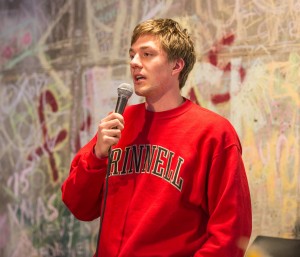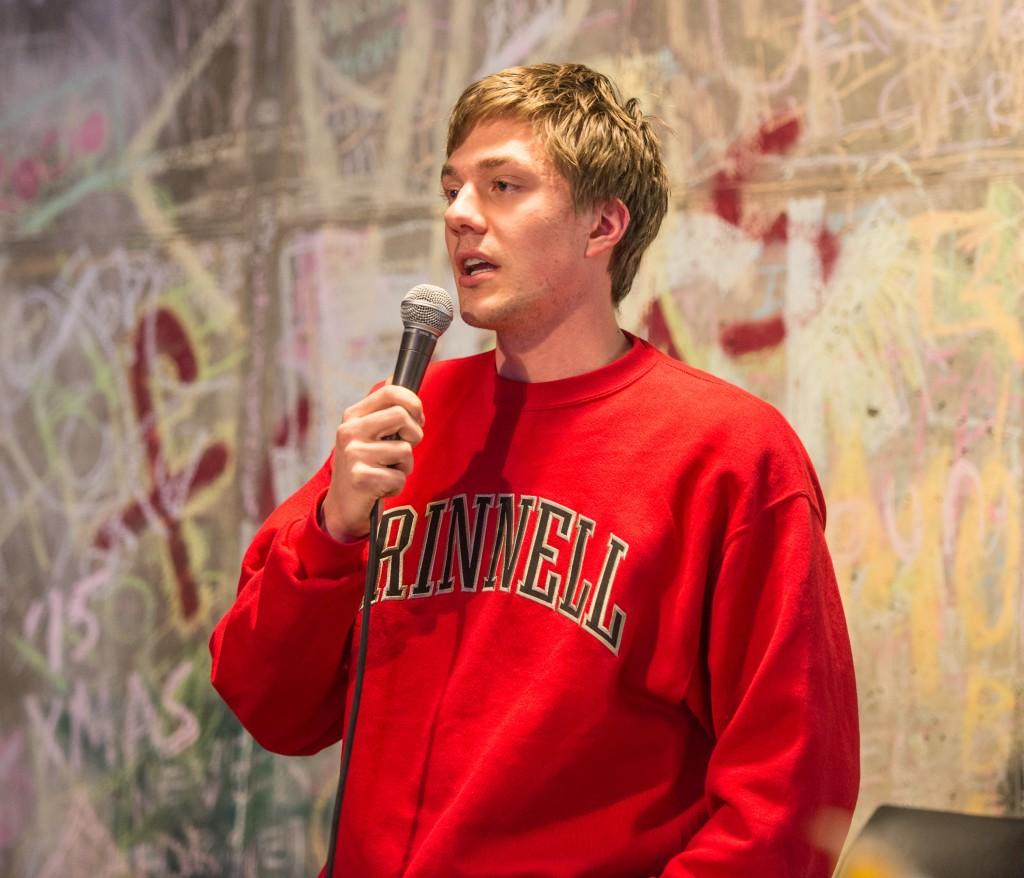Thursday night, Lyle’s Pub played host to Grinnell’s annual “State of the College” address. SGA President Thomas Neil ’13 spoke for half an hour concerning the challenges that the current SGA inherited from last year’s SGA and the progress of the semester so far.
Neil first noted the financial crisis, which he dubbed the “shitshow,” that the SGA received from last semester, which has caused them to spend with more caution.
“Honestly, the budget has been a blessing in disguise. I think it’s really been a useful constraint. It’s forced us to make more and do more with less and I think at the end of the day the organization is stronger for it,” he stated.
Neil went on to say that through events such as the two town halls earlier this semester, SGA is trying to promote pride within the organization. Neil also noted that the addition of student-athletes and North Campus residents as Cabinet members, senators and committee members seems to be addressing the issue of a campus divide, although he discouraged perpetuating the perceived issue.
“I’m not really sure it exists. And I think just continuing to discuss it doesn’t necessarily do us any favors. But with that being said, we did inherit the perception that there was a campus divide,” he said.
Speaking on Title IX and the issue of sexual assault, Neil stated that data on sexual misbehavior presented recently to the SGA is alarming.
“There’s really no greater priority than figuring out how we deal with [sexual assault] as a community,” Neil said.
The address also highlighted efforts by the SGA to increase representation of all Grinnellians by encouraging participation from underclassmen and through meetings with the Multicultural Leadership Council.
Other accomplishments observed by Neil were the renaming of Joint Board to Campus Council, the addition of both the Vice All Campus Events chair and the Diversity & Outreach Coordinator, as well as efforts to be more accountable and transparent.
Lastly, Neil summarized the semester for each department of SGA, especially pointing out that involvement among the student body has been high, namely in SGA committees, events such as the Sober Sex Retreat and attendance at movies.































































gp • Jan 18, 2014 at 11:31 am
For the last 70 years, American higher education was assumed to be the pathway to upper-mobility and a rich shared-learning experience.
Young Americans for four years took a common core of classes, learned to look at the world dispassionately, and gained the concrete knowledge to make informed arguments logically.
The result was a more skilled workforce and a competent democratic citizenry. That ideal may still be true at our flagship universities, with their enormous endowments and stellar world rankings.
Yet most elsewhere, something went terribly wrong with that model. Almost all the old campus protocols are now tragically outdated or antithetical to their original mission.
Tenure — virtual lifelong job security for full-time faculty after six years — was supposed to protect free speech on campus. How, then, did campus ideology become more monotonous than diverse, more intolerant of politically unpopular views than open-minded?
Universities have so little job flexibility that campuses cannot fire the incompetent tenured or hire full-time competent newcomers.
The university is often a critic of private enterprise for its supposed absence of fairness and equality. The contemporary campus, however, is far more exploitative. It pays part-time faculty with the same degrees far less for the same work than it pays an aristocratic class of fully tenured professors.
The four-year campus experience is simply vanishing. At the California State University system, the largest university complex in the world, well under 20 percent of students graduate in four years despite massive student aid. Fewer than half graduate in six years.
There are now more administrators in that system than full-time faculty.
College acceptance was supposed to be a reward for hard work and proven excellence in high school, not a guaranteed entitlement of open admission. Yet more than half of incoming first-year students require remediation in math and English during, rather than before attending, college. That may explain why six years and hundreds of million dollars later, about the same number never graduate.
The idea of deeply indebted college students in their 20s without degrees or even traditional reading and writing skills is something relatively new in America. Yet aggregate student debt has reached a staggering $1 trillion. More than half of recent college graduates — who ultimately support the huge college industry — are either unemployed or working in jobs that don’t require bachelor’s degrees. About a quarter of those under 25 are jobless and still seeking employment.
Apart from our elite private schools, the picture of our postmodern campus that emerges is one of increasing failure –a perception hotly denied on campus but matter-of-factly accepted off campus, where most of the reforms will have to originate.
What might we expect in the future?
Even more online courses will entice students away from campuses through taped lectures from top teachers, together with interactive follow-ups from teaching assistants — all at a fraction of current tuition costs.
Technical schools that dispense with therapeutic, hyphenated “studies” courses will offer students marketable skills far more cheaply and efficiently. Periodic teaching contracts, predicated on meeting teaching and research obligations, will probably replace lifelong tenure.
Public attitudes will also probably change. The indebted social science major in his mid-20s with or without a diploma will not enjoy the old cachet accorded a college-educated elite — at least in comparison with the debt-free, fully employed and higher-paid electrician, plumber or skilled computer programmer without a college degree.
Real skills will matter more than mere college attendance or a brand. New competency in national tests in math, science and English will be considered by employers to be a far better barometer of past achievement and future potential than the mere possession of a now-suspect university transcript.
As in any revolution, much good will be lost along with the bad. The traditional university used to offer a holistic four-year experience for motivated and qualified students in a landscape of shared inquiry and tolerance. The Internet and for-profit trade schools can never replace that unique intellectual and social landscape.
The college experience morphed into a costly sort of prolonged adolescence, a political arena and a social laboratory — something quite different from a serious place to acquire both practical and humanistic knowledge.
No wonder that it is now financially unsustainable and going the way of the dinosaurs.
truth • Jan 16, 2014 at 11:22 am
This is more a story idea — since you don’t seem to publish comments anymore. What is going on that the college isn’t anywhere around the Whitehouse Summit on higher education access? Look at the list of other schools and all they are planning to do. Where is Grinnell’s commitment, leadership, ideas, example or anything? WTF? All this social good stuff and the Grinn-Tower has nothing to add or say? And don’t buy into the “we don’t seek attention cuz we’re so pure/good” crap either. GC is spending tens of thousands on special image consultants for admission (art & science group), web make-over, the “brand” and all sorts of shit. Can’t find a way to look good when 100s of other schools can. For once, S&B, don’t be a wimp and really try to push and investigate. Betcha the threat over need-blind future wouldn’t be so bad if GC hired a few less adminstrator bloat lately. And you know why alums aren’t giving — cuz they see through the threats as pablum. Ray K has no clothes, but we can’t say that cuz he is ___ and ___ — 2 characteristics that make all the bleeding heart liberals coo and be afraid to speak the truth. Try it, S&B and you might save GC from itself.